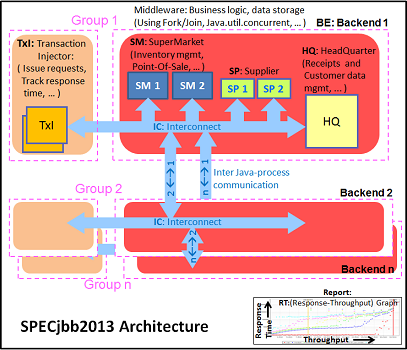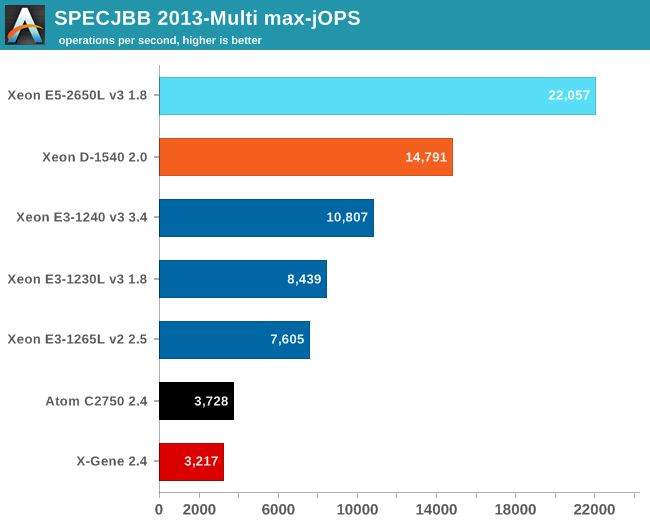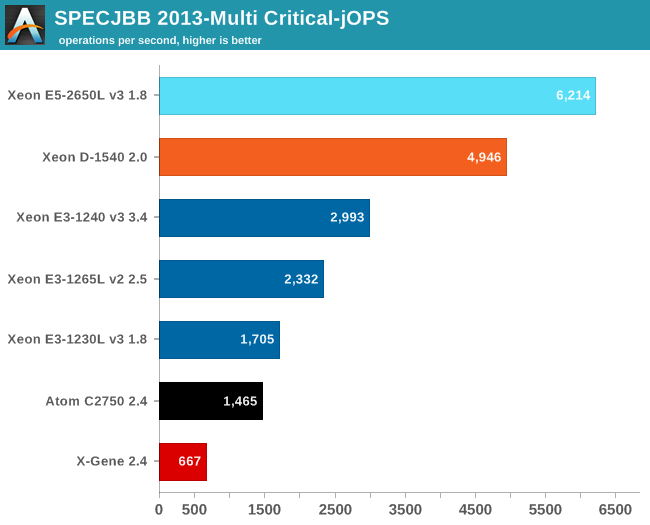The Intel Xeon D Review: Performance Per Watt Server SoC Champion?
by Johan De Gelas on June 23, 2015 8:35 AM EST- Posted in
- CPUs
- Intel
- Xeon-D
- Broadwell-DE
Java Server Performance
The SPECjbb 2013 benchmark has "a usage model based on a world-wide supermarket company with an IT infrastructure that handles a mix of point-of-sale requests, online purchases, and data-mining operations." It uses the latest Java 7 features and makes use of XML, compressed communication, and messaging with security.

We tested with four groups of transaction injectors and back-ends. We applied relatively basic tuning to mimic real-world use. We used this JVM configuration setting for the systems limited to 32 GB (all Xeon E3):
"-server -Xmx4G -Xms4G -Xmn2G -XX:+AlwaysPreTouch -XX:+UseLargePages"
With these settings, the benchmark takes about 20-27GB of RAM. For the servers that could address 64 GB or more (Atom, Xeon D and Xeon E5), we used a slightly beefier setting:
"-server -Xmx8G -Xms8G -Xmn4G -XX:+AlwaysPreTouch -XX:+UseLargePages"
With these settings, the benchmark takes about 43-57GB of RAM. The first metric is basically maximum throughput.

As long as you run enough JVMs on top your server, the Xeon D and Xeon E5 will not dissapoint. The Xeon D is at least 37% faster than the previous Xeon E3 generation, the Xeon E5 delivers 50% more.
The Critical-jOPS metric is a throughput metric under response time constraint.

The Xeon D seems to be slightly hindered by the lack of memory bandwidth in the max throughput benchmark, but less than in our HPC benchmark. It is important to understand that maximum throughput is very important in a HPC benchmark, but for a Java based back-end server, the critical benchmark matters much more than the maximum one. The reason is simple: the critical benchmark tells you what your customers will experience on a daily basis, the maximum throughput benchmark descibes what you will get in the worst case scenario when your server is pushed to its limits.
In the critical benchmark, the Xeon D is at least 65% faster than any Xeon E3. The Broadwell core is a minor improvement over the Haswell core when you look at performance only (single threaded integer performance), but once it is integrated in a chip like the Xeon D, it is astonishing how much performance per watt you get. A 60-70% increase in performance per watt is a rare thing indeed.










90 Comments
View All Comments
Krysto - Tuesday, June 23, 2015 - link
Betteridge law.Metaluna - Tuesday, June 23, 2015 - link
...fails in this case. Did you read the review?CajunArson - Tuesday, June 23, 2015 - link
While desktop Broadwell isn't all that great, these server parts really show off Intel's accomplishments in improving power efficiency and performance-per-watt with 14nm.ARM has a huge hill to climb to really compete with these parts, and we've already seen AMD effectively skip its first iteration of an ARM product because they probably got wind of the Xeon D and decided they would have to do both a die-shrink and completely customized ARM core just to keep up.
The_Assimilator - Tuesday, June 23, 2015 - link
I very much doubt whether we'll ever see another server CPU from AMD, regardless of ARM cores or not. If they even manage to get Zen out the door, *and* it's not another massive flop, I will be impressed.Refuge - Tuesday, June 23, 2015 - link
I root for them everyday, but lets not give them too big of a hill to climb with a broken leg now. lolextide - Tuesday, June 23, 2015 - link
Take it easy man, AMD is not going down the drain any time soon, and we WILL see some future server oriented parts come from them. But how fast will they be? That's the question and we wont know for a while...Kjella - Tuesday, June 23, 2015 - link
Really? Last quarter they had a $187 million total comprehensive loss on $1030 million in revenue, even if you exclude the restructuring cost they lost $100 million for a -10% deficit. The stockholder's equity is almost gone with $17 million left, after that getting funding or a credit limit will become much harder.And Q2 is probably going to be another bloody quarter with no major CPU or GPU launches and firesales of old Win8 stock in preparation for Win10. The console ramp-up is usually in Q3 in preparation for Christmas, not before the summer. Last quarter's loss they took almost entirely from their cash reserves, they're now in the lower end of what they need to operate, if they lose this quarter too they must cut where it hurts bad.
Guspaz - Tuesday, June 23, 2015 - link
When we needed a low-power and low-cost server solution, we went with a desktop i3, because for some reason Intel supports ECC RAM on the i3 and lower, but not in the i5 and higher.julianb - Tuesday, June 23, 2015 - link
Very interested in this SOC.If possible could we see how the Xeon D deal with Cinebench Multithreaded test?
I am into 3D CPU rendering and would like to know how does the Xeon D-1540 compare to say i7-3930K or i7-4790K.
I realize the purpose of Xeon D-1540's existence is different but still...
Thank you.
MrSpadge - Saturday, June 27, 2015 - link
An eco-tuned 5820K seem better. I don't suppose you're going to render 24/7 all the time, so the electricity savings from the 14 nm Broadwell will have a hard time making up for the massive difference in initial cost.